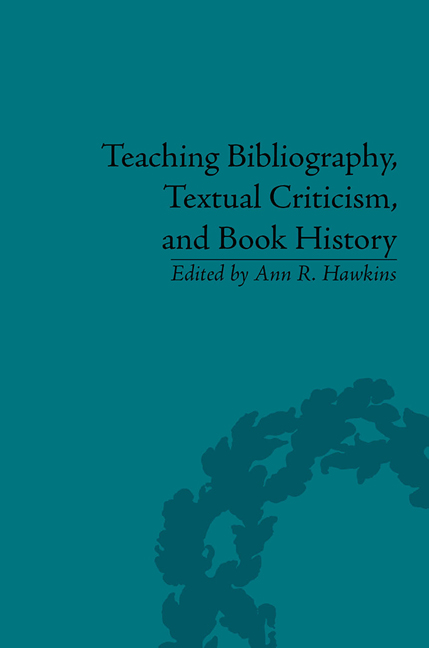Book contents
- Frontmatter
- Contents
- Notes on Contributors
- Foreword
- Introduction: Towards a pedagogy of Bibliography
- Part I Rationales
- Part II Creating and Using Resources
- Part III Methodologies
- Teaching ‘History of the Book’
- Teaching Bibliography and Research Methods
- Teaching Textual Criticism
- 20 How Things Work: Teaching the Technologies of Literature
- 21 ‘Not to Pick Bad from Bad, But By Bad Mend’: What Undergraduates Learn from Bad Editions
- 22 Book History and Reader-Response Theory: Teaching Shakespeare's Romeo and Juliet and King Lear
- 23 Textual Criticism: Students as Book Detectives and Scholarly Editors
- Afterword
- Part V Resources
- Index
23 - Textual Criticism: Students as Book Detectives and Scholarly Editors
from Teaching Textual Criticism
- Frontmatter
- Contents
- Notes on Contributors
- Foreword
- Introduction: Towards a pedagogy of Bibliography
- Part I Rationales
- Part II Creating and Using Resources
- Part III Methodologies
- Teaching ‘History of the Book’
- Teaching Bibliography and Research Methods
- Teaching Textual Criticism
- 20 How Things Work: Teaching the Technologies of Literature
- 21 ‘Not to Pick Bad from Bad, But By Bad Mend’: What Undergraduates Learn from Bad Editions
- 22 Book History and Reader-Response Theory: Teaching Shakespeare's Romeo and Juliet and King Lear
- 23 Textual Criticism: Students as Book Detectives and Scholarly Editors
- Afterword
- Part V Resources
- Index
Summary
In her fine essay on teaching book history to MLS students in this volume, Dierdre Stam opens with this sentiment: ‘I had been teaching book history surreptitiously for years before I was lucky enough to teach it openly … So secret was my pursuit that even I was barely aware of it’ (p. 72). Like Stam, it's hard for me to identify a particular moment when I started teaching the skills of textual criticism. I seem to have always been approaching texts in these ways, from the first time I taught the two versions of Sir Thomas Wyatt's ‘They flee from me’ from volume one of the Norton Anthology. That activity – a great one for helping students see the value of individual words in creating meaning – was also (though I didn't call it that) an exercise in collation, with students identifying the differences between the versions. I still use that activity, but I now introduce students to field-specific terms. As a class we determine our ‘copy-text’ based on information I give them about the origins (and uses) of the different versions, and they provide their results in an actual collation formula.
I can say, however, that in the past several years, my pedagogy has become more and more directed toward teaching with textual criticism.
- Type
- Chapter
- Information
- Teaching Bibliography, Textual Criticism, and Book History , pp. 174 - 177Publisher: Pickering & ChattoFirst published in: 2014



